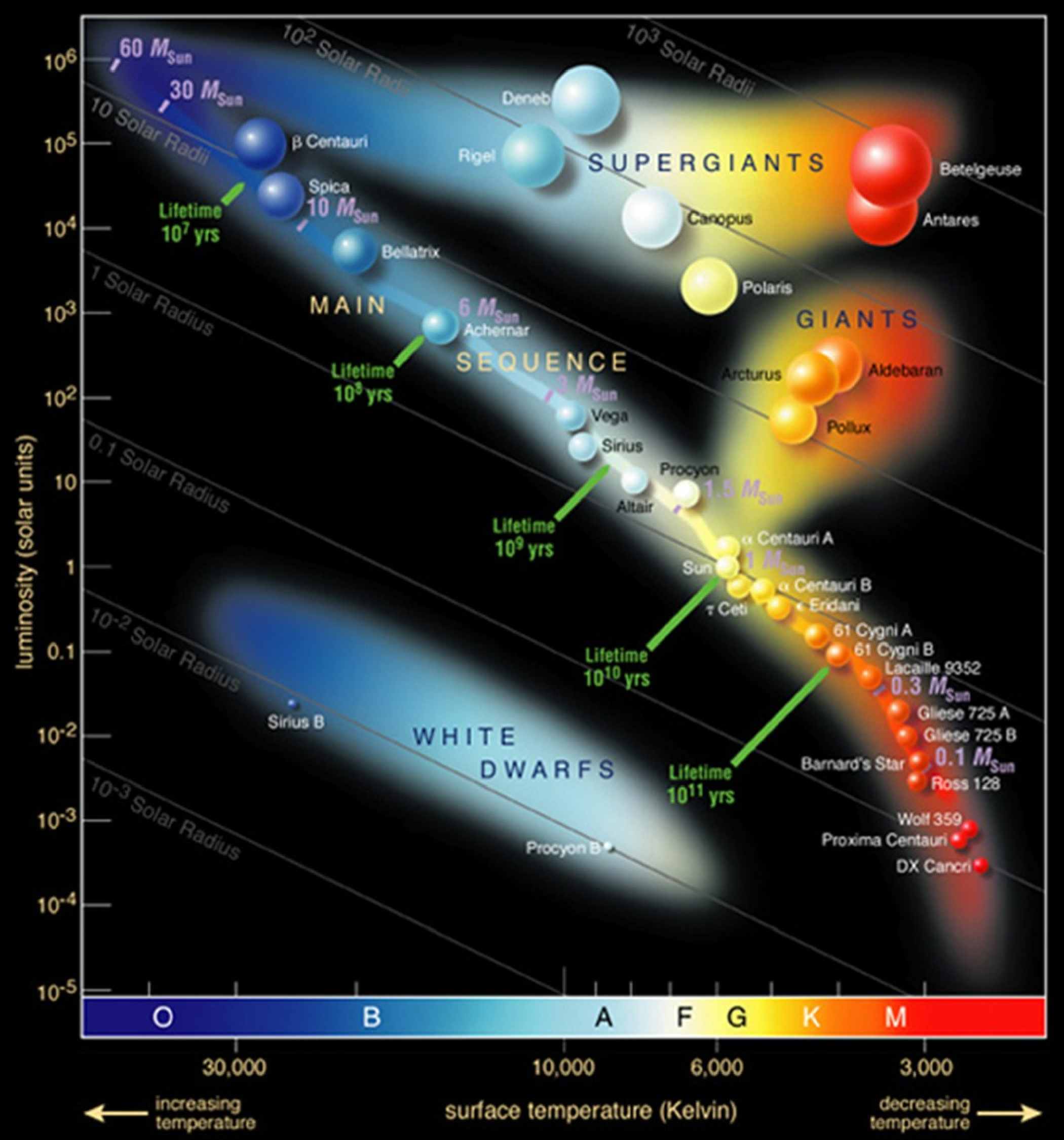Section 13.2 H-R Diagram

1
oneminuteastronomer.com/808/hr-diagram/The Hertzsprung-Russell Diagram or HR diagram is a graphical representation of the relationship between a star’s luminosity (or brightness) and temperature, and it provides a way to classify stars based on their properties. Using the HR diagram, astronomers can determine where a star is in its life cycle, from its birth as a protostar, through its evolution on the main sequence, to its eventual death as a white dwarf, neutron star, or black hole. HR diagram helps to categorize and analyze the properties of stars at different stages in their evolution. Here’s how to read the HR diagram Figure 13.2.1:
- Temperature: The horizontal axis of the HR diagram shows the temperature of stars, with the hottest stars on the left and the coolest stars on the right.
- Luminosity: The vertical axis of the HR diagram shows the luminosity (or brightness) of stars, with the most luminous stars at the top and the least luminous stars at the bottom. The luminosity is usually measured in units of solar luminosity, which is the amount of energy emitted by the Sun.
- Main sequence: The main sequence is a diagonal band that runs from the upper left to the lower right of the HR diagram. This band represents the majority of stars in the universe, including our Sun. The stars on the main sequence are fusing hydrogen into helium in their cores.
- Red giants and supergiants: Above and to the right of the main sequence are red giants and supergiants. These stars are much more luminous than main sequence stars but have lower surface temperatures.
- White dwarfs: Below and to the left of the main sequence are white dwarfs. These stars are much less luminous than main sequence stars but have higher surface temperatures.
- Stellar evolution: By looking at where a star is located on the HR diagram, astronomers can determine its stage of evolution. For example, a star that has moved off the main sequence and is located in the region of red giants is nearing the end of its life and is fusing heavier elements in its core.
A brown dwarf is a type of substellar object that is too massive to be classified as a planet but not massive enough to sustain nuclear fusion in its core to powers stars. Brown dwarfs have a mass between that of the heaviest gas giant planets and the lightest stars, typically ranging from about 13 to 80 times the mass of Jupiter. It can be called as a prenatal defects star. Because brown dwarfs cannot sustain nuclear fusion, they gradually cool and dim over time, eventually becoming cold and dark objects similar in temperature and appearance to planets. However, unlike planets, brown dwarfs form in the same way as stars, from the collapse of a cloud of gas and dust. Brown dwarfs are difficult to observe directly because they are relatively dim and emit most of their radiation in the infrared part of the spectrum. However, they can be detected by using their gravitational influence on nearby objects and the heat they emit as they cool.
A black dwarf is a hypothetical type of stellar remnant that is formed when a white dwarf, the final stage of stellar evolution for low-mass stars like the Sun, cools down and no longer emits significant amounts of light or heat. The formation of a black dwarf is a very slow process that would take trillions of years to occur. As the white dwarf cools down, it would lose its heat energy and become increasingly dimmer until it no longer emits any light. At this point, it would be considered a black dwarf. However, no black dwarfs are thought to exist in the universe yet, because the time required for a white dwarf to cool down to this state is much longer than the current age of the universe. The universe is currently estimated to be about 13.8 billion years old, which is not enough time for a white dwarf to cool down and become a black dwarf.
The size of stars can be determined by the position of stars on HR digram. The position of a star on the HR diagram is determined by its luminosity and temperature, which in turn are related to the star’s size and mass. Generally, more massive stars are larger and hotter, and they also have higher luminosities. Smaller stars, on the other hand, are cooler and less luminous.
The phrase OBA Fine Girl (Guy) Kiss Me is a mnemonic to remember the spectral sequence of stars from the hottest to the coolest, which corresponds to the order of spectral types O, B, A, F, G, K, and M. O-type stars are blue and located on the upper left of the diagram, while M-type stars are red and located on the lower right. Our Sun is classified as a G-type star, which is a main-sequence star that has a surface temperature of around 5,500 degrees Celsius (9,932 degrees Fahrenheit). G-type stars like the Sun have a yellow-white color and are located in the middle of the HR diagram.
